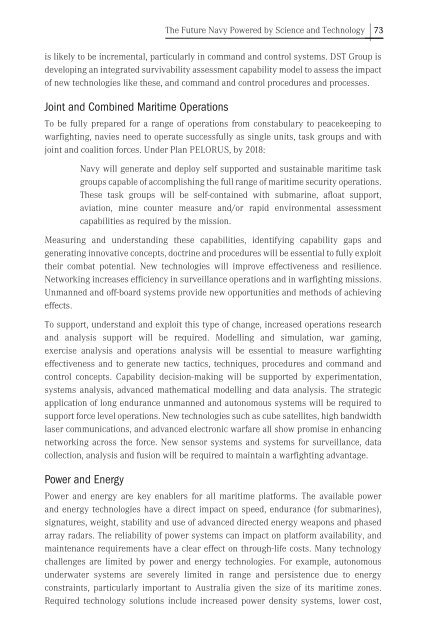THE FUTURE OF SEA POWER
SPC2015_Proceedings
SPC2015_Proceedings
Create successful ePaper yourself
Turn your PDF publications into a flip-book with our unique Google optimized e-Paper software.
The Future Navy Powered by Science and Technology | 73<br />
is likely to be incremental, particularly in command and control systems. DST Group is<br />
developing an integrated survivability assessment capability model to assess the impact<br />
of new technologies like these, and command and control procedures and processes.<br />
Joint and Combined Maritime Operations<br />
To be fully prepared for a range of operations from constabulary to peacekeeping to<br />
warfighting, navies need to operate successfully as single units, task groups and with<br />
joint and coalition forces. Under Plan PELORUS, by 2018:<br />
Navy will generate and deploy self supported and sustainable maritime task<br />
groups capable of accomplishing the full range of maritime security operations.<br />
These task groups will be self-contained with submarine, afloat support,<br />
aviation, mine counter measure and/or rapid environmental assessment<br />
capabilities as required by the mission.<br />
Measuring and understanding these capabilities, identifying capability gaps and<br />
generating innovative concepts, doctrine and procedures will be essential to fully exploit<br />
their combat potential. New technologies will improve effectiveness and resilience.<br />
Networking increases efficiency in surveillance operations and in warfighting missions.<br />
Unmanned and off-board systems provide new opportunities and methods of achieving<br />
effects.<br />
To support, understand and exploit this type of change, increased operations research<br />
and analysis support will be required. Modelling and simulation, war gaming,<br />
exercise analysis and operations analysis will be essential to measure warfighting<br />
effectiveness and to generate new tactics, techniques, procedures and command and<br />
control concepts. Capability decision-making will be supported by experimentation,<br />
systems analysis, advanced mathematical modelling and data analysis. The strategic<br />
application of long endurance unmanned and autonomous systems will be required to<br />
support force level operations. New technologies such as cube satellites, high bandwidth<br />
laser communications, and advanced electronic warfare all show promise in enhancing<br />
networking across the force. New sensor systems and systems for surveillance, data<br />
collection, analysis and fusion will be required to maintain a warfighting advantage.<br />
Power and Energy<br />
Power and energy are key enablers for all maritime platforms. The available power<br />
and energy technologies have a direct impact on speed, endurance (for submarines),<br />
signatures, weight, stability and use of advanced directed energy weapons and phased<br />
array radars. The reliability of power systems can impact on platform availability, and<br />
maintenance requirements have a clear effect on through-life costs. Many technology<br />
challenges are limited by power and energy technologies. For example, autonomous<br />
underwater systems are severely limited in range and persistence due to energy<br />
constraints, particularly important to Australia given the size of its maritime zones.<br />
Required technology solutions include increased power density systems, lower cost,


